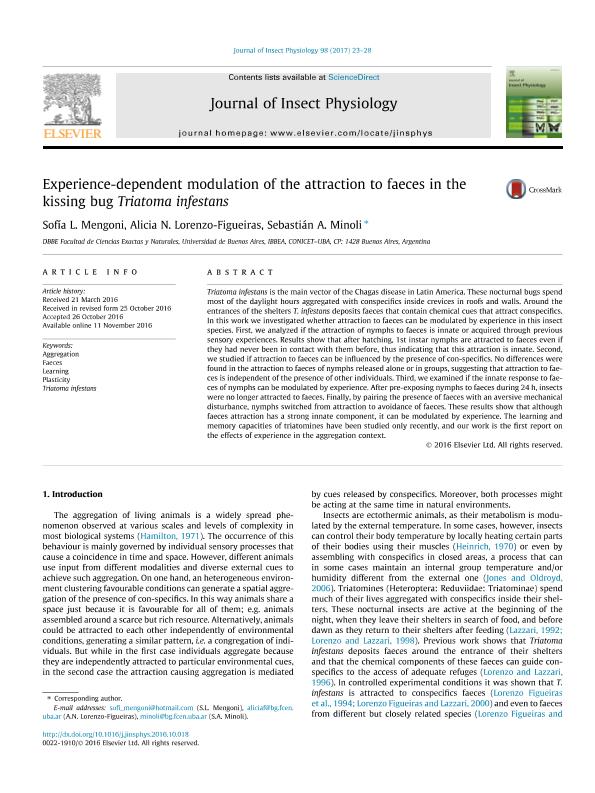Mostrar el registro sencillo del ítem
dc.contributor.author
Mengoni, Sofia Laura

dc.contributor.author
Lorenzo Figueiras, Alicia Nieves

dc.contributor.author
Minoli, Sebastian Antonio

dc.date.available
2019-01-10T19:15:34Z
dc.date.issued
2017-04
dc.identifier.citation
Mengoni, Sofia Laura; Lorenzo Figueiras, Alicia Nieves; Minoli, Sebastian Antonio; Experience-dependent modulation of the attraction to faeces in the kissing bug Triatoma infestans; Pergamon-Elsevier Science Ltd; Journal of Insect Physiology; 98; 4-2017; 23-28
dc.identifier.issn
0022-1910
dc.identifier.uri
http://hdl.handle.net/11336/67905
dc.description.abstract
Triatoma infestans is the main vector of the Chagas disease in Latin America. These nocturnal bugs spend most of the daylight hours aggregated with conspecifics inside crevices in roofs and walls. Around the entrances of the shelters T. infestans deposits faeces that contain chemical cues that attract conspecifics. In this work we investigated whether attraction to faeces can be modulated by experience in this insect species. First, we analyzed if the attraction of nymphs to faeces is innate or acquired through previous sensory experiences. Results show that after hatching, 1st instar nymphs are attracted to faeces even if they had never been in contact with them before, thus indicating that this attraction is innate. Second, we studied if attraction to faeces can be influenced by the presence of con-specifics. No differences were found in the attraction to faeces of nymphs released alone or in groups, suggesting that attraction to faeces is independent of the presence of other individuals. Third, we examined if the innate response to faeces of nymphs can be modulated by experience. After pre-exposing nymphs to faeces during 24 h, insects were no longer attracted to faeces. Finally, by pairing the presence of faeces with an aversive mechanical disturbance, nymphs switched from attraction to avoidance of faeces. These results show that although faeces attraction has a strong innate component, it can be modulated by experience. The learning and memory capacities of triatomines have been studied only recently, and our work is the first report on the effects of experience in the aggregation context.
dc.format
application/pdf
dc.language.iso
eng
dc.publisher
Pergamon-Elsevier Science Ltd

dc.rights
info:eu-repo/semantics/openAccess
dc.rights.uri
https://creativecommons.org/licenses/by-nc-sa/2.5/ar/
dc.subject
Aggregation
dc.subject
Faeces
dc.subject
Learning
dc.subject
Plasticity
dc.subject
Triatoma Infestans
dc.subject.classification
Otras Ciencias Biológicas

dc.subject.classification
Ciencias Biológicas

dc.subject.classification
CIENCIAS NATURALES Y EXACTAS

dc.title
Experience-dependent modulation of the attraction to faeces in the kissing bug Triatoma infestans
dc.type
info:eu-repo/semantics/article
dc.type
info:ar-repo/semantics/artículo
dc.type
info:eu-repo/semantics/publishedVersion
dc.date.updated
2019-01-02T18:33:37Z
dc.journal.volume
98
dc.journal.pagination
23-28
dc.journal.pais
Países Bajos

dc.journal.ciudad
Amsterdam
dc.description.fil
Fil: Mengoni, Sofia Laura. Consejo Nacional de Investigaciones Científicas y Técnicas; Argentina. Universidad de Buenos Aires. Facultad de Ciencias Exactas y Naturales. Departamento de Biodiversidad y Biología Experimental. Laboratorio de Fisiología de Insectos; Argentina
dc.description.fil
Fil: Lorenzo Figueiras, Alicia Nieves. Consejo Nacional de Investigaciones Científicas y Técnicas; Argentina. Universidad de Buenos Aires. Facultad de Ciencias Exactas y Naturales. Departamento de Biodiversidad y Biología Experimental. Laboratorio de Fisiología de Insectos; Argentina
dc.description.fil
Fil: Minoli, Sebastian Antonio. Consejo Nacional de Investigaciones Científicas y Técnicas; Argentina. Universidad de Buenos Aires. Facultad de Ciencias Exactas y Naturales. Departamento de Biodiversidad y Biología Experimental. Laboratorio de Fisiología de Insectos; Argentina
dc.journal.title
Journal of Insect Physiology

dc.relation.alternativeid
info:eu-repo/semantics/altIdentifier/doi/https://dx.doi.org/10.1016/j.jinsphys.2016.10.018
dc.relation.alternativeid
info:eu-repo/semantics/altIdentifier/url/https://www.sciencedirect.com/science/article/pii/S0022191016300385
Archivos asociados
